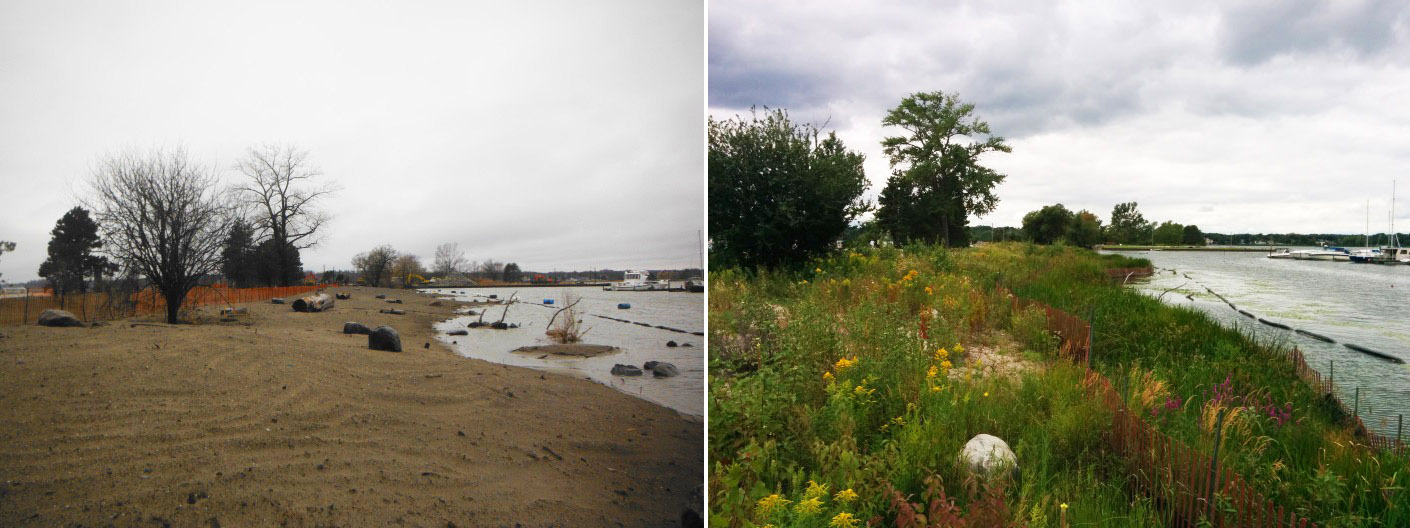WHY RESTORE SHORELINES?
Shorelines in the Greater Toronto Area (GTA) are very different today than they were before European settlement.
Historically, shorelines in Toronto region provided rich aquatic and terrestrial habitats including bluffs, beaches, cobble reefs, estuaries, productive marshes and wooded shorelines.
Development and port expansion changed the waterfront over the years, leading to habitat loss, reduced water quality and shoreline erosion.

The benefits of shoreline restoration include:
- Increased fish, water bird and wildlife habitat
- Improved shoreline habitat through the planting of trees, shrubs and wildflowers
- Stabilized shorelines
- Improved recreational opportunities
- Improved water quality
- Fewer beach closures
HOW IS TRCA RESTORING SHORELINES?
Shoreline restoration usually involves the addition of boulders and logs to protect the shoreline from wave action and erosion, along with the planting of riparian and emergent aquatic vegetation to further stabilize banks and provide habitat for aquatic species.
Toronto and Region Conservation Authority (TRCA) also restores and creates various types of shoreline habitat, including sheltered embayments, coastal wetlands and estuaries.
TRCA SHORELINE RESTORATION PROJECTS
Frenchman’s Bay Shoreline
In 2013, TRCA commenced shoreline restoration of Frenchman’s Bay in the City of Pickering. The project involved the creation and restoration of an emergent vegetation area, the creation of armor stone lookouts, protected boulder shoreline (with basking logs and rocks), and the removal and cleanup of debris along the shoreline.

Heart Lake Shoreline
In 2001, TRCA proposed a multi-year shoreline naturalization program to help improve the fish community and water quality of Heart Lake.
The 2008 Heart Lake shoreline restoration project involved the removal of gabion basket structures, establishment of emergent vegetation, and installation of root wads and logs to stabilize the shore and provide aquatic habitat and basking areas.
In total, TRCA restored 250 metres of shoreline.

Tommy Thompson Park Embayment A
In 2009, TRCA commenced shoreline restoration of Embayment A in Tommy Thompson Park.
This restoration project aimed to create a functional shoreline community through the establishment of emergent and riparian vegetation and the creation of nursery and juvenile fish habitat.
The final project resulted in:
- 1 kilometer of protected shoreline
- 5 hectares of habitat
- 1 hectare of emergent and riparian vegetation
- Essential habitat for birds, reptiles, and amphibians
- A warm water refuge for fish

LEARN MORE ABOUT SHORELINE RESTORATION
Aquatic Habitat Toronto (AHT): Aquatic Habitat Toronto represents a consensus-based partnership between agencies with a vested interest in the improvement of aquatic habitat on the Toronto Waterfront. Partners include Fisheries and Oceans Canada, Ministry of Natural Resources and Forestry, and Toronto and Region Conservation Authority (TRCA) in consultation with City of Toronto. LEARN MORE.
Toronto Waterfront Aquatic Habitat Restoration Strategy (TWAHRS): Aquatic Habitat Toronto is responsible for the implementation of the Toronto Waterfront Aquatic Habitat Restoration Strategy. The TWAHRS strategy strives to create a more sustainable waterfront by using an ecosystem approach to increase ecological integrity, to provide suitable conditions for the maintenance of self-sustaining aquatic communities, and to improve ecological connectivity. LEARN MORE.
Toronto and Region Remedial Action Plan: The Toronto and Region Remedial Action Plan (RAP) works to restore Toronto’s waters, fish, wildlife and habitats with the ultimate goal of delisting Toronto as a Great Lakes Area of Concern. It is managed by representatives from Environment and Climate Change Canada, Ministry of the Environment, Conservation and Parks, Ministry of Natural Resources and Forestry, and Toronto and Region Conservation Authority (TRCA). LEARN MORE
